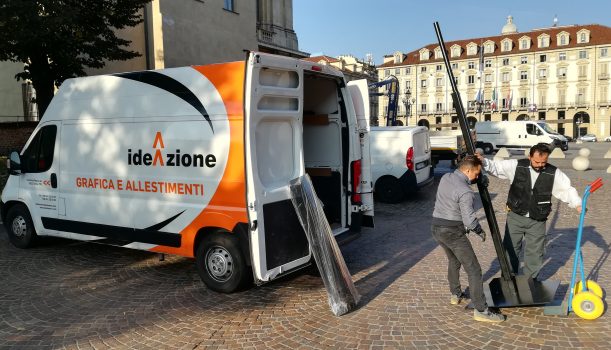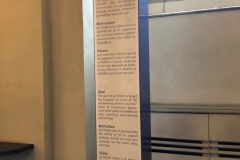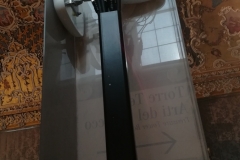In the month of October, the works related to the implementation of the 5G network solution at Palazzo Madama have been finally concluded. Result of the joint effort of TIM and Ericsson (with the collaboration of Fondazione Torino Musei), the 5G network solution has been designed to satisfy the most stringent requirements in terms of bandwidth and latency coming from the different use cases: 800 Mbps/cell for the downlink from UC1 “Augmented Tourism Experience” in which multiple users (e.g. up to 30 devices) will download multimedia contents of considerable dimensions such as 3D scans of artefacts; 80 Mbps/cell for the uplink from UC5 “Remote and distributed video production” in which 4 concurrent high definition video streams with a bit rate of 20 Mbps each will be transmitted on the uplink; latency of less than 10 ms from UC2 “Telepresence” and UC3 “Robot Assisted Museum Guide” for a proper behavior of the robots’ navigation systems as well as from UC5 to deliver the video streams with a minimum and constant delay.
From the architectural point of view, the solution is based on the so-called Option 3 NSA (Non-standalone) defined by 3GPP in which the control plane relies on LTE technology (defined as “anchor”) while the user plane takes full advantage of the potential provided by the NR (New Radio) access. Being connected to the TIM on-field CN (Core Network), the indoor 5G coverage of Palazzo Madama integrates perfectly with the outdoor commercial network, effectively constituting an ad-hoc high-performance extension of it. Preliminary tests showed outstanding performances, reaching up to 1.2 Gbps on the downlink, 116 Mbps on the uplink and very low latencies in the order of few milliseconds.
If on one hand the solution adopted complies with the 3GPP standard, despite some peculiarities such as the connection of the radio units with a remote baseband (i.e. 5G fronthauling), on the other hand, the fact of having to install it inside a historic structure protected by the Superintendency of Archeology, Fine Arts and Landscape, required a considerable innovative effort in terms of design to cope with the intrinsic complexities of the environment in which the solution would operate. From this perspective, for the insertion of the technological components within the museum context, especially in the courtly rooms of Palazzo Madama, a UNESCO heritage site, the design had to take into consideration and balance different needs: the requirements with respect to the positioning and choice of the appropriate transparent radio materials to house the antenna system, the technical constraints relating to the possibility of powering the equipment safely, the technical difficulties of cabling for the fiber optic connection of the radio units in a building with multiple historical stratifications and, last but not least, the aesthetic requirements necessary to integrate the equipment inside the rooms. All these factors made it necessary to identify an extremely flexible radio solution also in terms of used equipment, which could be installed without supports or wiring on the wall and ceiling; this particular requirement has resulted in the creation of an ad-hoc mechanical system for fixing the radio unit combined with the choice of designing new room furnishings, coordinated with those existing and in use, which practically re-functionalized the room seating and panels with the curatorial texts.
The work carried out, thanks to the precious collaboration between TIM, Ericsson and Fondazione Torino Musei, resulted in an innovative and “zero impact” indoor 5G radio solution within a museum (the first in Italy) and in recognition of which the Superintendency has granted a permission for a permanent installation until the end of the project. In general, the theme of “friendliness” with the environment of radio solutions (5G and future ones) in terms of visual-architectural impact is considered so important that the European Commission will most probably dedicate a proper space to it in the next calls for funded projects. In this sense, the 5G network solution implemented by 5G-TOURS can undoubtedly be considered the state of the art.
The first 5G-TOURS trial on the 5G network solution at Palazzo Madama took place the 9th of November as the “itinerant orchestra” concert (see the related news here). All the other UCs’ trials on augmented and virtual reality, telepresence and robotics will be performed starting from early 2022. In the meanwhile, the works for the 5G indoor coverage at GAM (Modern Art Gallery) museum have already been started…
Relevant links:
Video of the installation activity: https://www.youtube.com/watch?v=dHDsNGE7fys
5G-TOURS deliverable: D4.2 “First Touristic City use case results” (section 7), D3.3 “Technologies, architecture and deployment advanced progress” (section 4.1)










